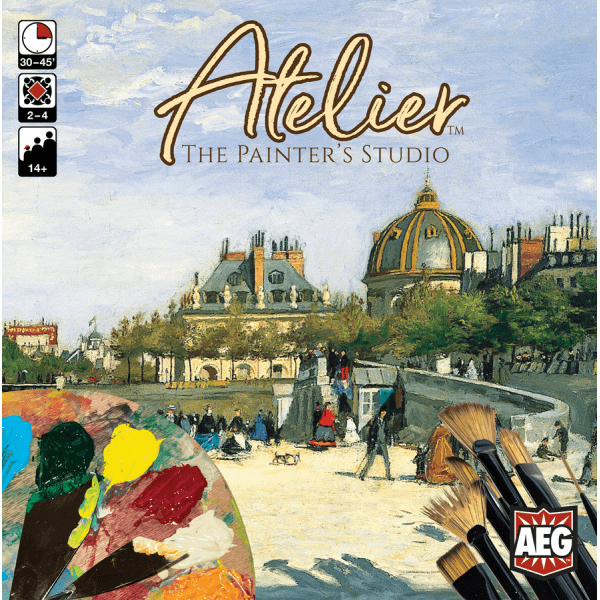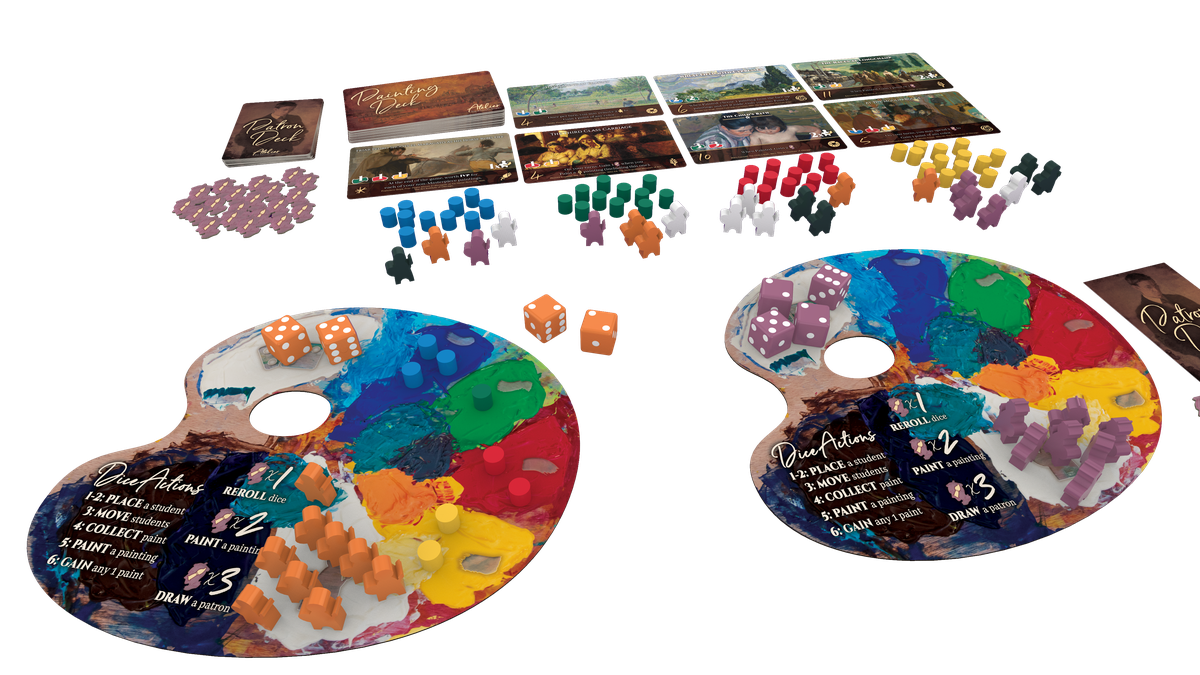Create the Best Gallery in Atelier: The Painter's Studio

Create enough masterpieces to fill an art studio and gain the adoration of patrons.
Gameplay
Atelier is a 2-4 player game where area control and engine building collide. Players are given twelve assistant meeples, four dice, and an inspiration token to place on their player boards. Before them will be a gallery of seven paintings, each with a different requirement to complete, as well as four piles of colored pieces (blue, green, yellow, and red). Players will then be dealt two cards from the Patron cards, selecting one to keep and discarding the other.
Everyone will roll their four dice and follow the instructions laid out on their player boards. Starting with the first player, each person will choose an action to carry out by the pip value on one of their dice. Dice with 1 and 2 allow players to place an assistant in front of any of the paint color piles, 3 will allow players to move an assistant from one pile to another, 4 will allow players to collect a color from a pile, 5 gives players the opportunity to complete a painting from one of the seven currently available (if they have met the requirements), and 6 allows a player to take one color from any pile of their choosing. Players can also elect to spend a die to collect an inspiration token, which will allow players to reroll dice, complete a painting, or draw a card from the Patron deck. Players continue to use a die clockwise around the table until the round is over, either with players having used all their dice or having spent all of the inspiration tokens to carry out actions.
The goal of the game is to earn the most points from completing paintings and meet the desires of their drawn patrons. Patron cards are additional goals, and provide an element of set collection (collect paintings that use the color red, collect paintings from a particular era, etc.). Categories (Impressionist, Post-Impressionist, Realist, and Romantic) are denoted by symbols on the cards to allow for easy notation. For players to fulfill the needs of a painting, they must collect a specific number of colors by maneuvering their assistants within the color piles to have the majority, and carefully collecting colors when opportunities arise. Some paintings will also ask for other requirements (such as having assistants at a specific color pile) to be able to fulfill the requirements in obtaining a particular painting.
Masterpiece paintings are denoted with a star underneath the title of the paintings. Once a player has successfully completed three masterpiece paintings, the round will finish out (or an additional round will commence if the player is currently last in player order) and the player with the most points will be declared the winner.

Review
Atelier is a great example of a gateway game, introducing people to variable mechanics (area control, engine building, set collection) without overwhelming them. This is evident in the rule book, which is a quick 5 minute read. Set-up is just as quick, making the game perfect in tight time windows.
The area control aspect of Atelier is the most interesting, as players decide which paintings they are aiming to complete (determined by Patron cards as well as the point values on each painting). There is an element of take that involved as players can try to negate majorities or load up a particular color in an effort to dissuade others from trying to outmaneuver them. However, inspiration tokens and dice offer opportunities to get around these power plays.
Likewise, a game where a player may be suffering a string of bad rolls can be mitigated by inspiration tokens. With the ability to use a die to gain an inspiration token rather than carry out the action associated with the pip value, players can shift strategies as necessary to stay competitive. Once a painting is completed, it can also offer a continuing benefit that players can leverage in future rounds to allow for maneuverability.
Although the end game of Atelier is triggered after someone completes three masterpieces, there are benefits to not chasing masterpieces. The set collection aspect offers players a chance to leverage their Patron cards to full effect. While some award one victory point for each completed painting using a specific color, others offer increasing benefits if you collect a set number of paintings that match a particular category — the point value may be far greater than racing to end the game. However, this delay can cause a game to drag on too long if players are choosing to chase big points and not enough masterpiece paintings are being completed.
Despite having multiple means to mitigate bad dice rolls, a streak of bad luck is also demoralizing. Inspiration tokens help a bit (especially if a player has the colors necessary to complete a painting but can’t seem to roll a five), but frustration is still a deterrent for some players.
Yet, the good far outweighs these minor negatives. The game’s components are good quality and the paintings are real (this was done in partnership with four museums). There is a healthy stack of paintings in the base game to complete, each with its own benefits. The game will only get better with future expansions but they won’t be necessary for gamers who understand Atelier’s position as a fun, lightweight game.
Pros: Family-friendly, multiple mechanisms that work well together, real-life art, strategic depth
Cons: Games can run long, consistent bad luck in dice rolls can be frustrating




